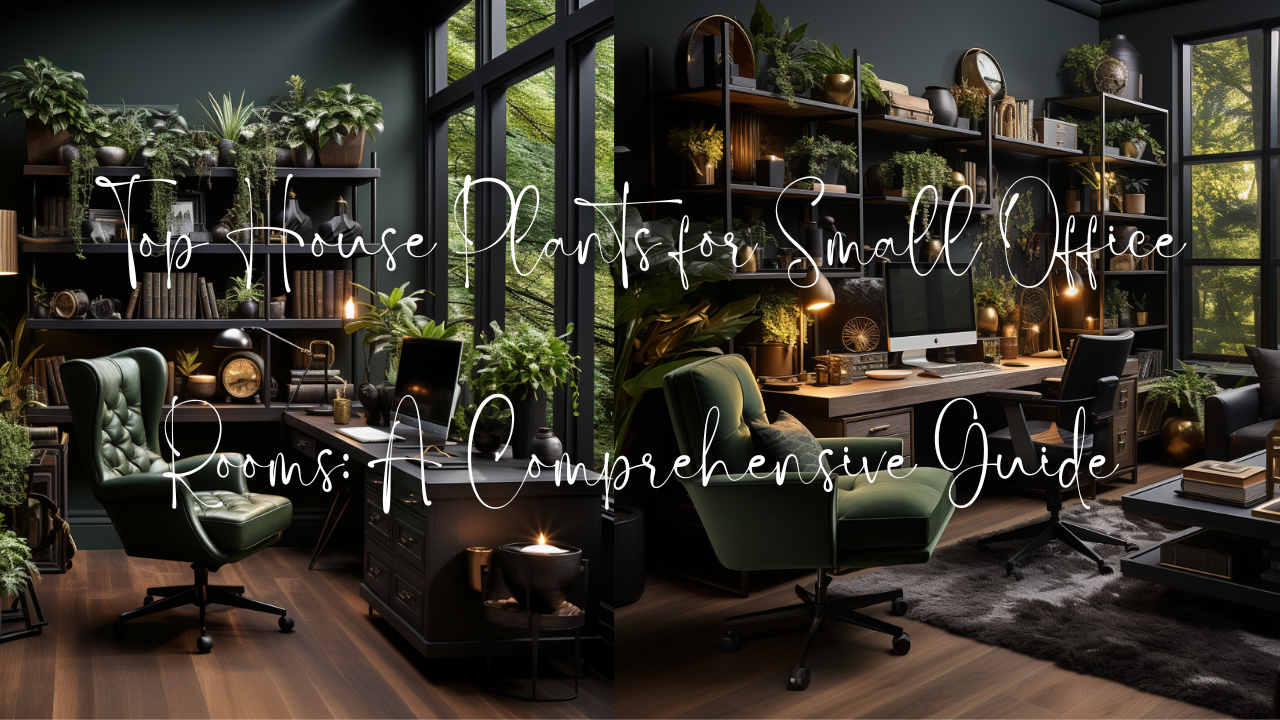Creating a lively and vibrant atmosphere in a small office room can greatly enhance productivity and overall well-being. Houseplants are an excellent way to achieve this, as they not only add a touch of greenery but also purify the air and boost morale. Here's a comprehensive guide to the top houseplants suitable for small office rooms:
1. Snake Plant (Sansevieria trifasciata):
Light: low to indirect light
Handle with care: Let the soil dry out in between applications of water.
Benefits: excellent air purifier, releases oxygen at night, and is resilient to neglect.
2. Peace Lily (Spathiphyllum):
Light: indirect light
Benefits: removes toxins like ammonia, benzene, and formaldehyde from the air; beautiful white blooms
3. ZZ Plant (Zamioculcas zamiifolia):
Light: low to indirect light
Benefits: tolerates low light conditions, is highly drought-resistant, and removes toxins like xylene, toluene, and benzene.
4. Spider Plant (Chlorophytum comosum):
Light: indirect light
Care: Keep the soil evenly moist; it enjoys high humidity.
Benefits: purifies air by removing pollutants like formaldehyde and xylene; produces baby plants (spiderettes) for propagation.
5. Pothos (Epipremnum aureum):
Light: low to indirect light
Benefits: Versatile, easy to care for, excellent air purifier, and removes toxins like formaldehyde, xylene, and benzene.
6. Rubber Plant (Ficus elastica):
Light: indirect light
Care: Keep the soil slightly moist; avoid overwatering.
Benefits: It removes toxins like formaldehyde and has large, glossy leaves that add an aesthetic appeal to the office space.
7. Aloe Vera (Aloe barbadensis Miller):
Light: indirect light
Care: Allow the soil to dry out completely between waterings.
Benefits: Known for its healing properties, it requires minimal care and removes airborne toxins.
8. Bamboo Palm (Chamaedorea seifrizii):
Light: indirect light
Care: Keep the soil consistently moist; it thrives in high humidity.
Benefits: excellent air purifier, particularly effective in removing formaldehyde and benzene; adds a tropical touch to the environment.
9. Jade Plant (Crassula ovata):
Light: bright, indirect light
Benefits: It symbolizes prosperity and good luck, requires minimal maintenance, and adds a unique aesthetic with its succulent leaves.
10. Succulents:
Light: bright, indirect light
Care: Allow the soil to dry out completely between waterings.
Benefits: The diverse range of species available is low-maintenance and comes in various shapes and sizes, adding visual interest to the office space.
When choosing houseplants for a small office room, consider factors like lighting conditions, maintenance requirements, and the overall aesthetic appeal. Mix and match these plants to create a green oasis that not only enhances the ambiance but also promotes a healthier and more productive work environment. Remember to water the plants appropriately, provide occasional fertilization, and occasionally rotate them to ensure even growth. With the right care, these plants can transform your small office room into a lively and refreshing space.
When Is the Best Time to Plant House Plants for Small Office Rooms?
The best time to plant houseplants for small office rooms primarily depends on the specific plants you're choosing. However, in general, the ideal time for planting or repotting houseplants is during the spring or early summer months. Here are the reasons why this period is considered optimal:
1. Spring and Early Summer:
a. Warmth and Light:
During spring and early summer, there is an increase in natural sunlight and warmer temperatures. This provides an ideal environment for plants to establish their roots and start growing vigorously.
b. Active Growth Phase:
Most houseplants enter an active growth phase during spring and summer. Planting or repotting during this time allows them to take advantage of the growing season, promoting healthy foliage and root development.
c. Recovery Period:
Plants often experience stress during the transplantation process. Spring and early summer offer a longer period of milder weather, which helps plants recover from the shock of being moved or repotted.
d. Optimal Conditions for Root Growth:
Warmer soil temperatures in spring and summer encourage robust root growth. Healthy roots are essential for the overall health and vitality of the plant.
e. Preparation for Indoor Living:
Planting in spring or early summer allows the plants to acclimate to indoor conditions gradually. They can adjust to the lower light levels and controlled environment inside your office room.
Considerations for Indoor Planting:
a. Transition Period:
If you're bringing outdoor plants inside for your office room, it's advisable to do so gradually. Start by placing them in a shaded, protected area to help them adjust to indoor conditions.
b. Avoiding Extreme Temperatures:
Try to avoid transplanting during heatwaves or cold snaps. Extreme temperatures can stress plants, making the transition more challenging.
c. Plant-Specific Needs:
Some plants have specific growing seasons or dormancy periods. Research the particular requirements of the plants you're interested in to ensure you're planting them at an appropriate time.
d. Regular Care:
Regardless of the planting time, ensure consistent care for your plants. Monitor their water, light, and humidity needs to help them thrive indoors.
In summary, the best time to plant houseplants for small office rooms is during the spring or early summer when the weather is mild, and plants are entering their active growth phase. This timing provides optimal conditions for establishment and allows the plants to adapt gradually to indoor settings. Remember to consider individual plant requirements and provide consistent care to help them flourish in your office space.
Bringing Nature Indoors: House Plants for Small Office Rooms
Bringing nature indoors through houseplants can transform a small office room into a refreshing and lively space. Not only do indoor plants enhance the aesthetic appeal, but they also improve air quality, reduce stress, and boost productivity. When selecting houseplants for small office rooms, it's essential to consider factors such as lighting conditions, maintenance requirements, and available space. Here are some suitable houseplants for small office rooms along with their characteristics:
1. Snake Plant (Sansevieria trifasciata):
Light: Low to indirect light
After watering, let the soil dry out.
Benefits: Excellent air purifier, releases oxygen at night, and adds a touch of elegance with its upright leaves.
2. Peace Lily (Spathiphyllum):
Light: Indirect light
Care: Keep soil consistently moist, prefers higher humidity
Benefits: Removes toxins like ammonia, benzene, and formaldehyde; beautiful white blooms enhance the room's ambiance.
3. ZZ Plant (Zamioculcas zamiifolia):
Light: Low to indirect light
Care: Allow the soil to dry out between waterings
Benefits: Tolerant of low light conditions, highly drought-resistant, and removes toxins like xylene, toluene, and benzene.
4. Spider Plant (Chlorophytum comosum):
Light: Indirect light
Care: Keep soil evenly moist; enjoys high humidity
Benefits: Purifies air by removing pollutants like formaldehyde and xylene; produces baby plants (spiderettes) for propagation.
5. Pothos (Epipremnum aureum):
Light: Low to indirect light
Take care: Let the soil dry out in between waterings.
Benefits: Versatile, easy to care for, excellent air purifier, and removes toxins like formaldehyde, xylene, and benzene.
6. Rubber Plant (Ficus elastica):
Light: Indirect light
Care: Keep soil slightly moist; avoid overwatering
Benefits: Removes toxins like formaldehyde and has large, glossy leaves that add an aesthetic appeal to the office space.
7. Aloe Vera (Aloe barbadensis miller):
Light: Indirect light
Care: Allow the soil to dry out completely between waterings
Benefits: Known for its healing properties; requires minimal care and removes airborne toxins.
8. Bamboo Palm (Chamaedorea seifrizii):
Light: Indirect light
Care: Keep the soil consistently moist; thrives in high humidity
Benefits: Excellent air purifier, particularly effective in removing formaldehyde and benzene; adds a tropical touch to the environment.
9. Jade Plant (Crassula ovata):
Light: Bright, indirect light
Handling: Let the ground dry out in between soakings
Benefits: Symbolizes prosperity and good luck; requires minimal maintenance and adds a unique aesthetic with its succulent leaves.
10. Succulents:
Light: Bright, indirect light
Care: Allow the soil to dry out completely between waterings
Benefits: Diverse range of species available, low-maintenance, and come in various shapes and sizes, adding visual interest to the office space.
Tips for Arranging Houseplants in Small Office Rooms:
Utilize Vertical Space: Hang plants in macramé planters or place them on floating shelves to optimize vertical space.
Group Plants: Cluster plants together to create a lush, cohesive look. Grouping plants of varying heights and sizes adds visual interest.
Use Decorative Pots: Choose pots in different colors, materials, and patterns to match the room's decor. Decorative pots can enhance the overall aesthetic.
Consider Low-Maintenance Options: If you have limited time for plant care, opt for low-maintenance plants like snake plants and ZZ plants that require minimal attention.
Rotate Plants: Rotate plants occasionally to ensure all sides receive adequate light, promoting even growth.
Regular Maintenance: Water plants as per their specific requirements and remove dead leaves to keep them looking vibrant and healthy.
By incorporating these houseplants and following these tips, you can create a harmonious indoor garden in your small office room, fostering a calming and productive environment.
10 Tips for Choosing the Right House Plants for Small Office Rooms
Choosing the right houseplants for a small office room involves considering factors like lighting, maintenance, size, and aesthetic preferences. Here are ten tips to guide you in selecting the most suitable plants for your workspace:
1. Assess Lighting Conditions:
Light Levels: Determine the amount of natural light your office room receives. Select plants that will flourish in the given light. Low-light plants like snake plants and ZZ plants are ideal for spaces with minimal sunlight.
2. Consider Space and Size:
Compact Plants: Opt for compact plants that fit well on desks, shelves, or windowsills. Plants like succulents, small peace lilies, and mini cacti are space-efficient options.
3. Evaluate Maintenance Requirements:
Low-Maintenance Plants: If you have a busy schedule, choose plants that require minimal care. Succulents, snake plants, and pothos are low-maintenance options that can thrive with occasional watering.
4. Identify Air Purifying Plants:
Air-Cleaning Plants: Select plants that have air-purifying qualities. Plants like peace lilies, spider plants, and rubber plants can help improve indoor air quality by removing toxins.
5. Consider Aesthetic Appeal:
Decorative Plants: Choose plants that complement the room's decor. Consider plants with unique foliage or colorful flowers to add visual interest to your workspace.
6. Mind Allergies and Sensitivities:
Non-Allergenic Plants: If you or your colleagues have allergies, avoid plants with heavy pollen. Plants like ferns, succulents, and most palms are generally safe for individuals with allergies.
7. Address Pet Safety:
Pet-Friendly Plants: If you have pets, ensure the plants you choose are non-toxic to animals. Plants such as Boston ferns, spider plants, and bamboo palms are safe options around pets.
8. Plan for Vertical Space:
Hanging or Wall-Mounted Plants: Utilize vertical space by hanging plants in macramé hangers or placing them on wall-mounted shelves. This saves desk or floor space.
9. Introduce Fragrance:
Fragrant Plants: Consider plants with pleasant fragrances to create a soothing environment. Herbs like lavender, rosemary, and mint not only smell delightful but can also be used in teas.
10. Research and Ask for Advice:
Consult Plant Care Guides: Research specific plant care requirements and growth habits before making a choice. Also, consult with local nurseries or gardening experts to get recommendations tailored to your office's specific conditions.
By keeping these tips in mind, you can select houseplants that not only thrive in your small office room but also contribute positively to the ambiance and overall work environment. Remember to provide the necessary care, water, and light to help your chosen plants flourish in your workspace.

